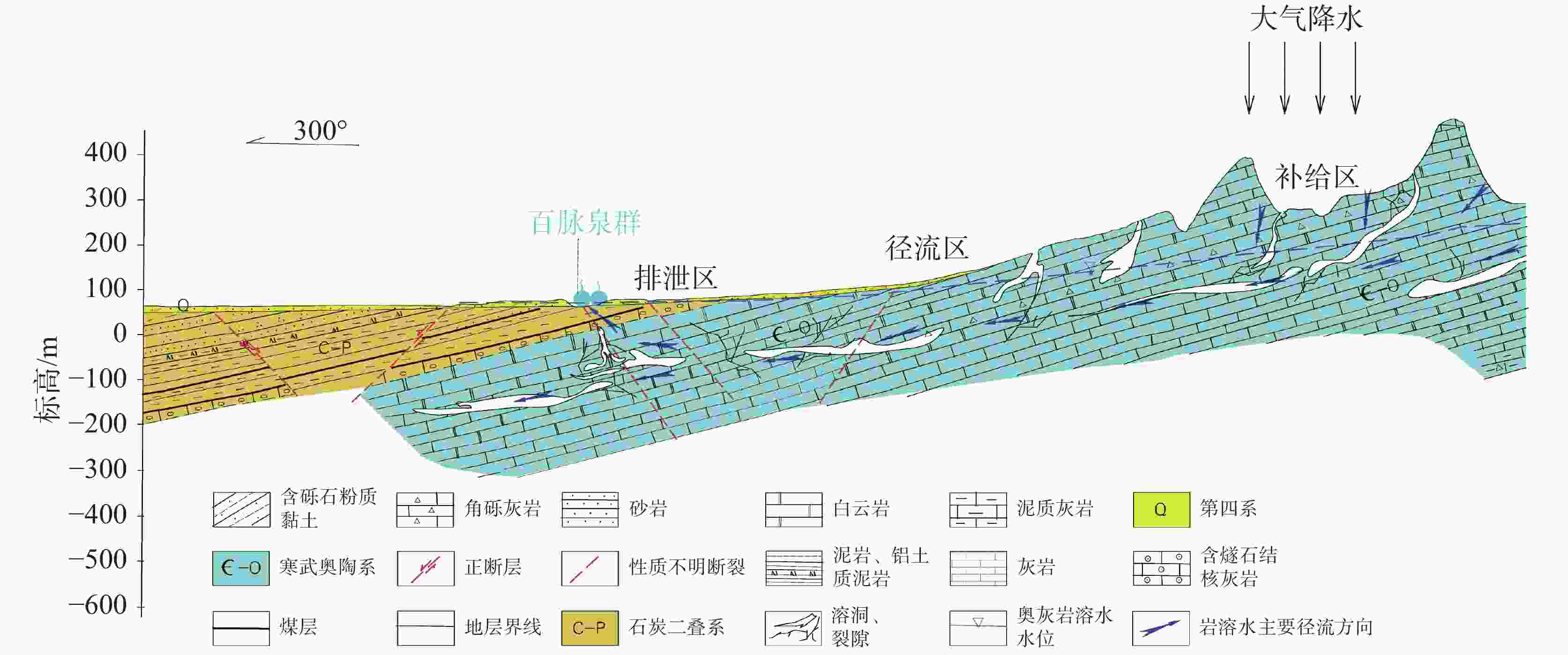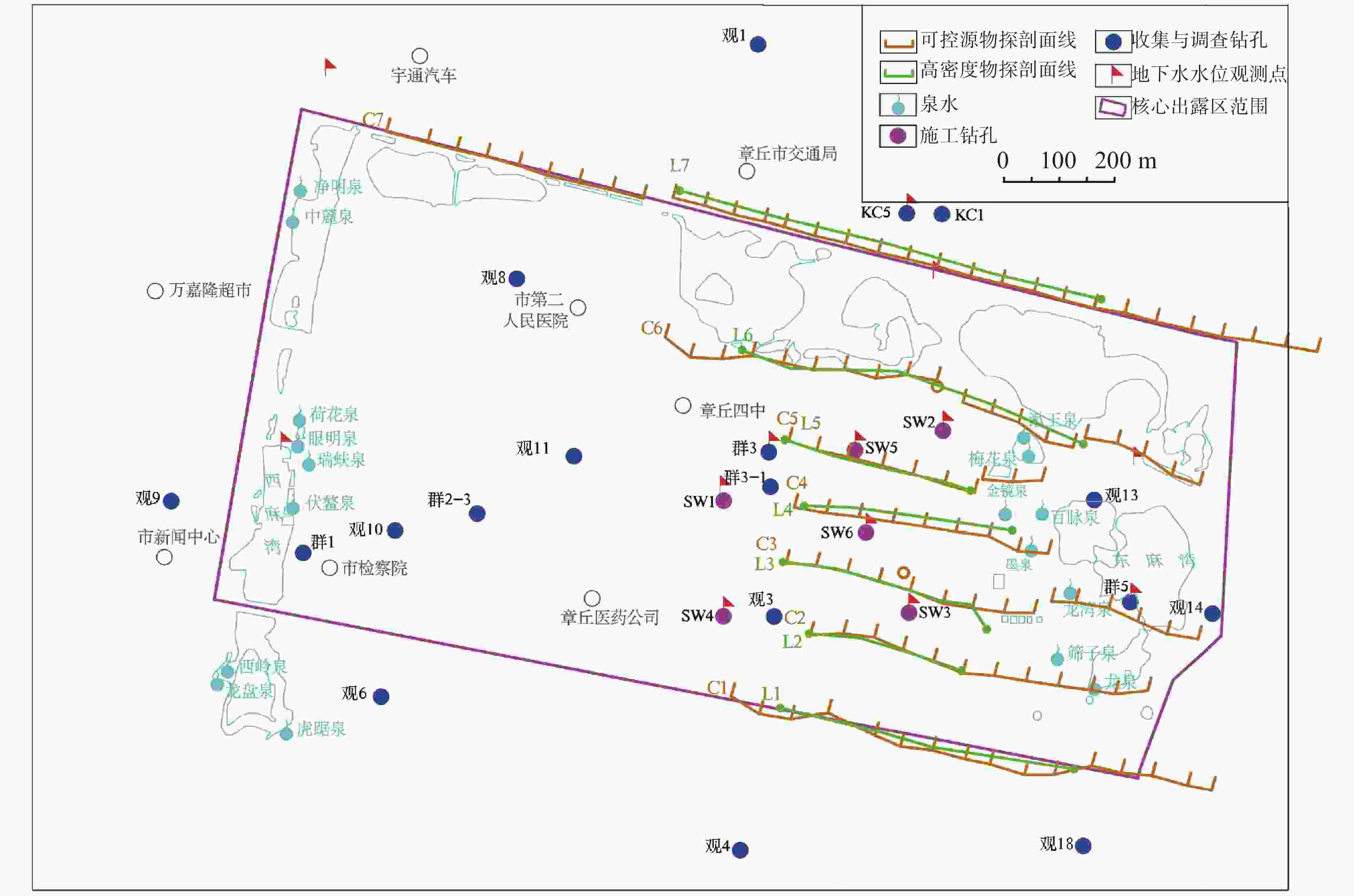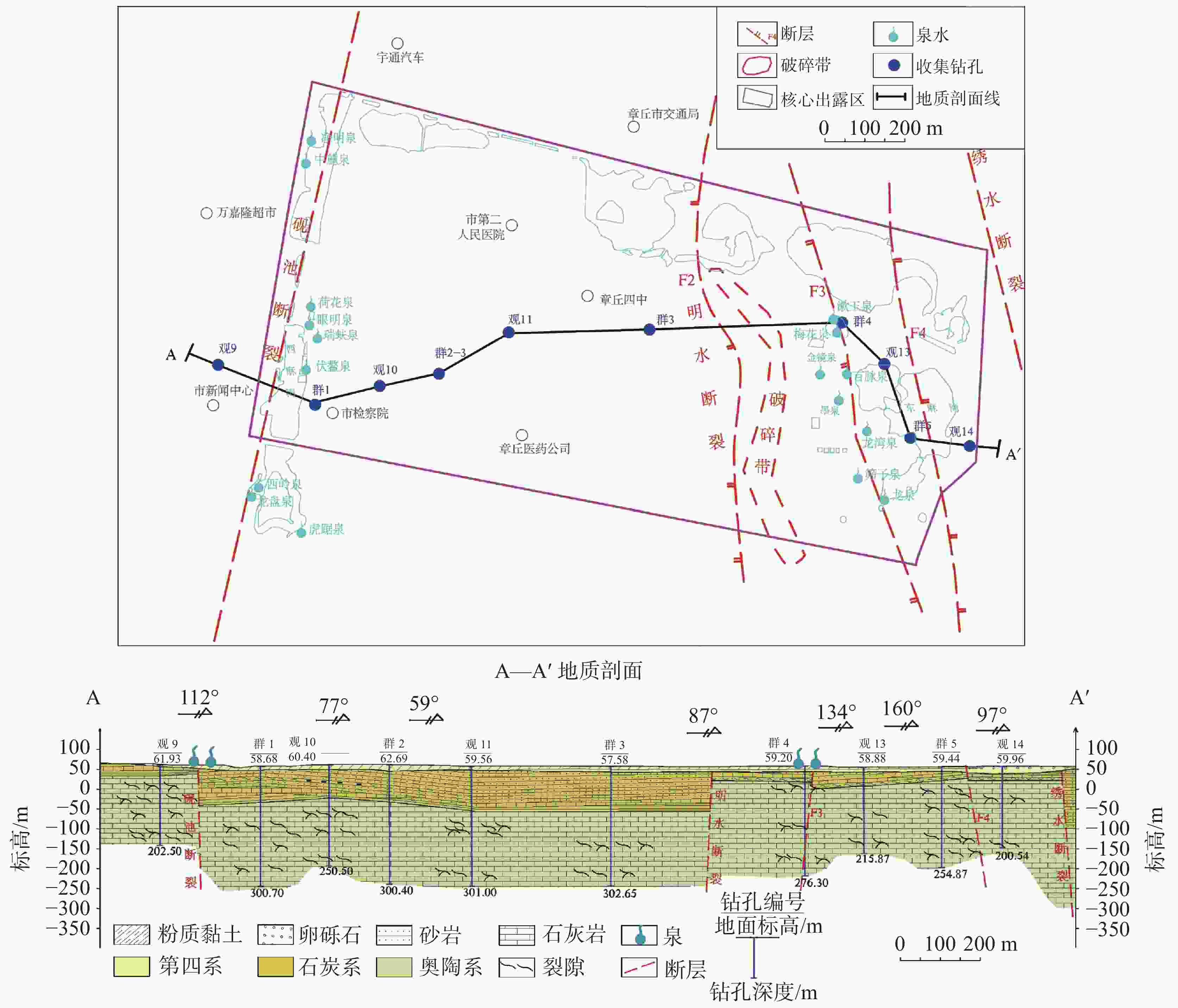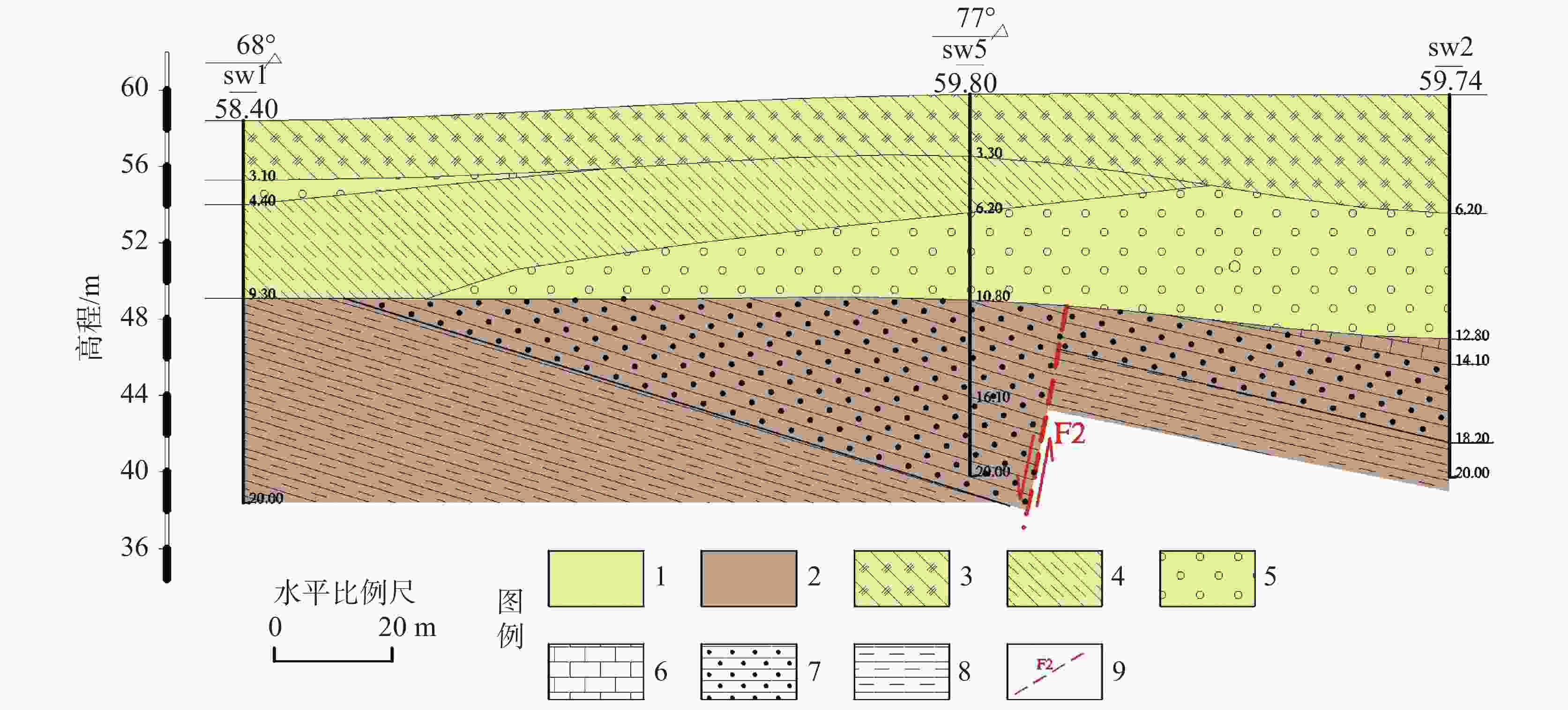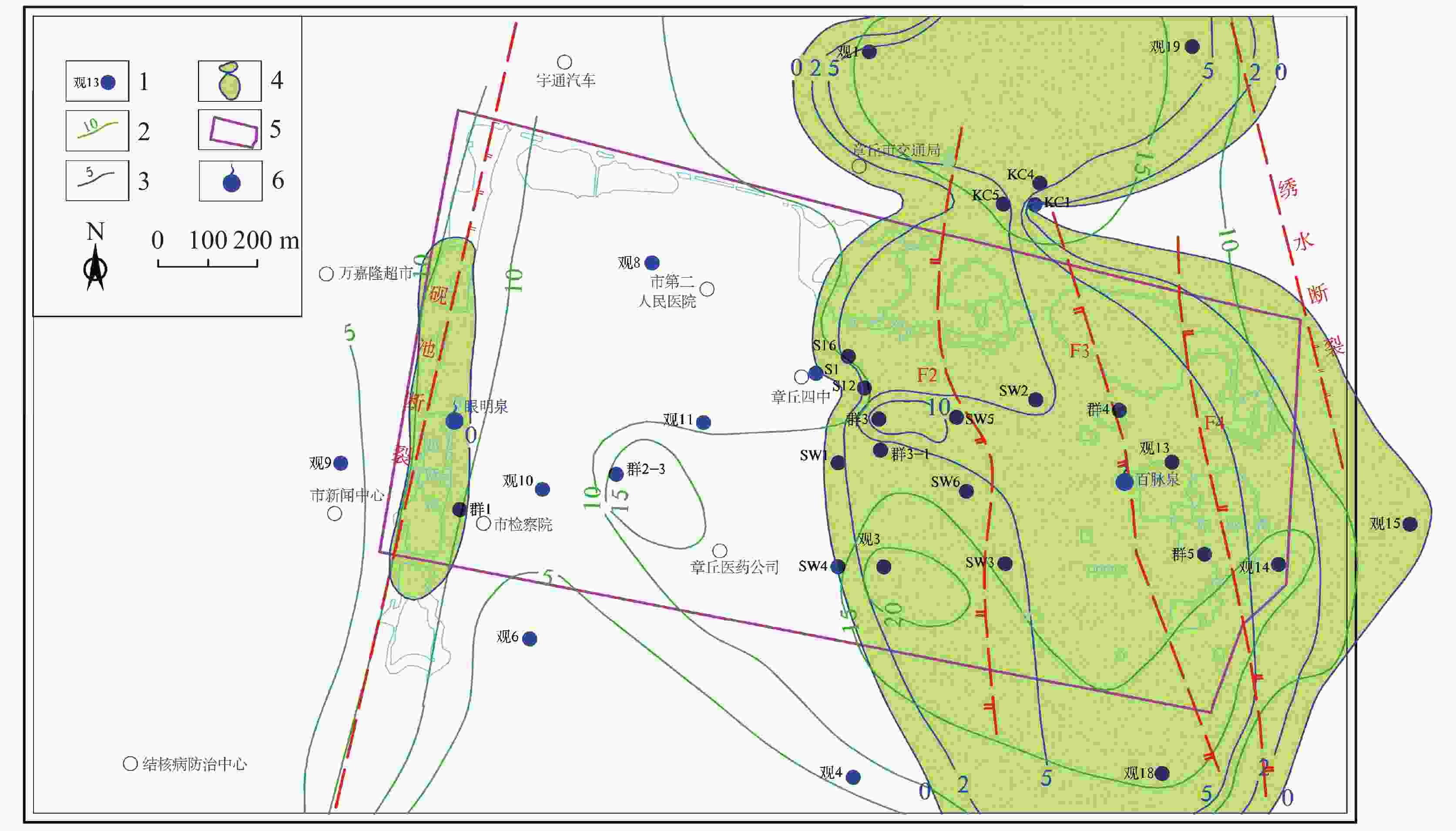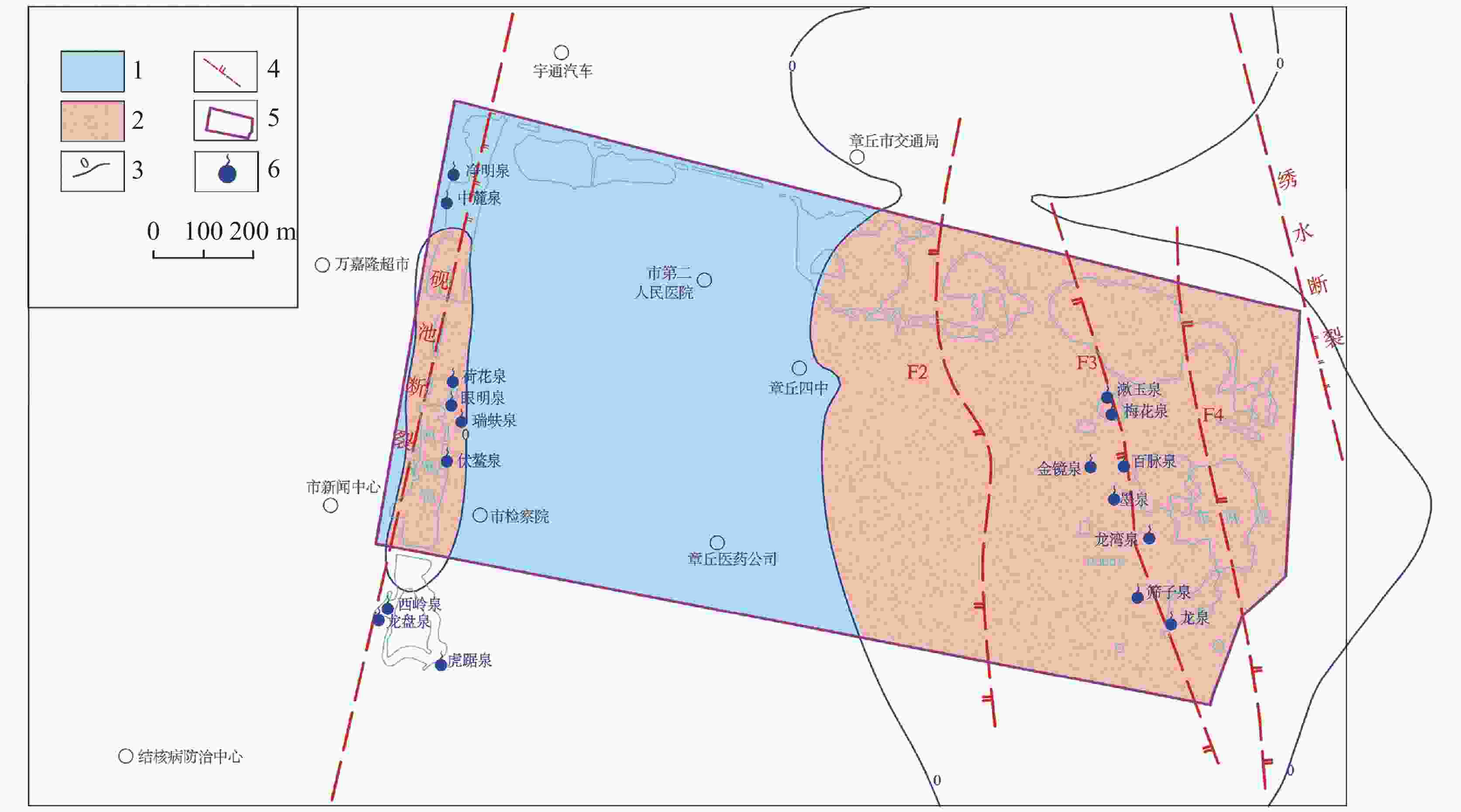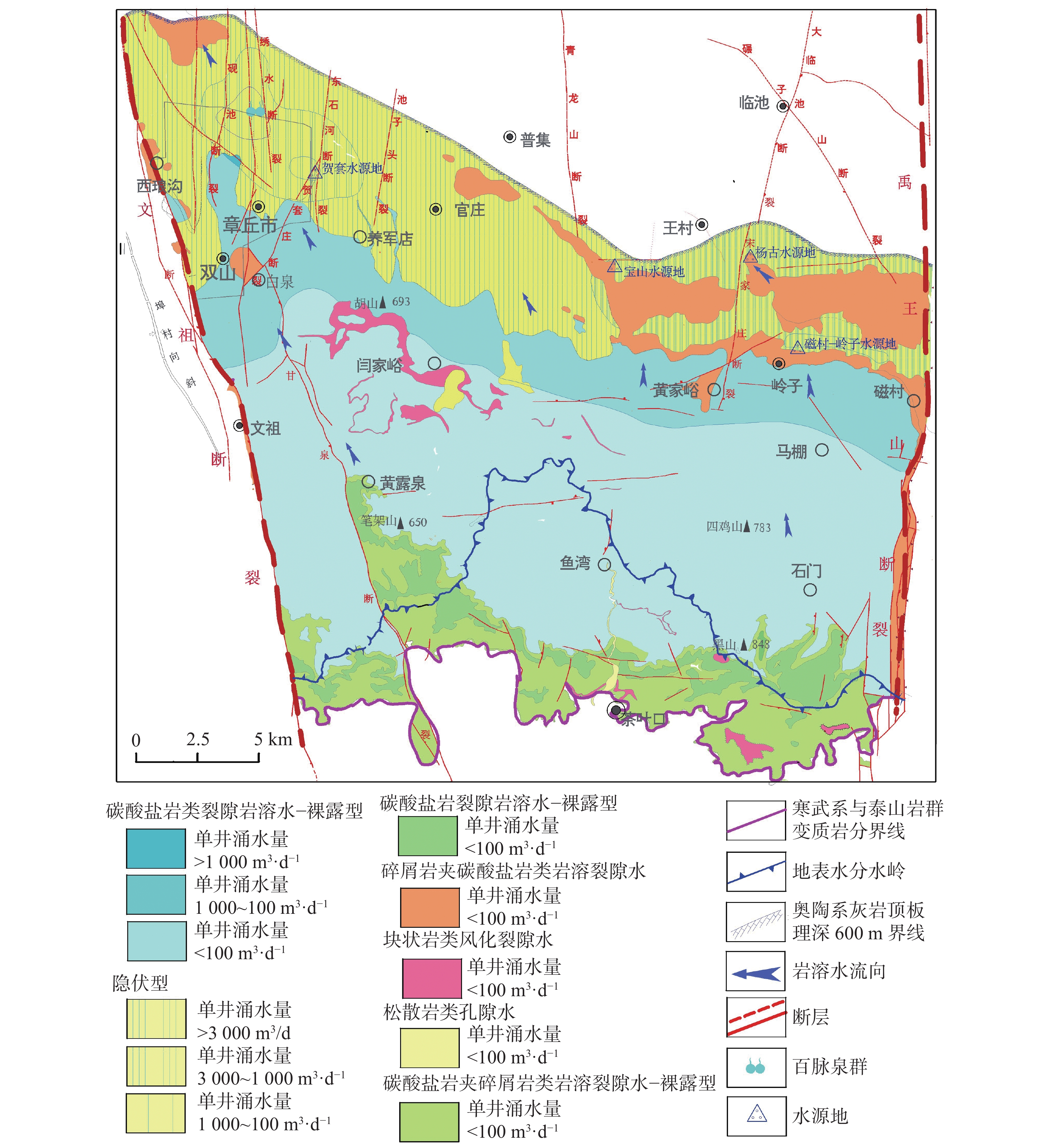Hydrochemical characteristics and delimitation of sensitive protection area in the exposed area of Baimai spring group in Zhangqiu
-
摘要: 为了查清章丘百脉泉出露区浅部微观地质条件及其与泉水的关系,通过物探、钻探、水位观测等多种手段,查明断裂构造发育特征,刻画泉水出露区浅部地层结构,分析出露区泉水喷涌主要影响因素,划分敏感保护区范围。结果表明:出露区断裂构造极为发育,共发育5条断层、1个破碎带,为岩溶水上涌提供了通道;卵砾石层在断裂两侧普遍发育,呈现中间厚向两侧变薄并逐渐尖灭的特征,卵砾石层为泉水上涌后提供了赋存空间,在埋藏较浅处涌出成泉。出露区影响泉水喷涌的主要因素为断裂构造的控制作用和卵砾石层的连通、透水作用。综合断裂构造和卵砾石层的发育厚度划分了敏感区和较敏感区,面积分别为0.78 km2和0.67 km2。Abstract:
Zhangqiu is rich in spring resources, known as the "Little Spring City", and Baimai spring group is among the 72 famous springs in Jinan. In recent years, the flow of Baimai spring group has been cut off for many times, and the competent departments have implemented a series of spring protection measures to basically maintain the continuous gushing of spring water. Against the backdrop of the planned development and construction of the core exposed area of the spring group, it is urgent to investigate the shallow micro-stratigraphic structure of the exposed area and its relationship with the spring water, in order to avoid the negative effect of engineering construction on the gushing of spring water. Based on the data collected from years of exploration for water supply in the exposed area of spring, this study has been conducted to identify the shallow stratigraphic structure and structural development characteristics of the exposed area of spring, with the methods of geophysical exploration, drilling, and water level observation. Meanwhile, the main influencing factors of spring water gushing in the exposed area have been analyzed, and the sensitive protection area has been delimited. The research findings may provide a scientific basis for the development and construction of the core exposed area of the spring group, and also for the spring water protection. The results show that the fault structures in the exposed area are highly developed, with a total of 5 faults and 1 fracture zone, becoming a channel for karst water upwelling. The distribution of spring water is closely related to structural development. The West Mawan spring group is mainly controlled by the Yanchi fault, with spring water distributed along both sides of the Yanchi fault, while the East Mawan spring group is mainly distributed along the secondary fault F3 of the Mingshui fault. The gravel layer is widely developed on both sides of the fault, showing a characteristic of thinning and gradually pinching out from the middle to both sides. The gravel layer is in direct contact with the underlying Permian Carboniferous bedrock, and the structure cuts the Permian Carboniferous aquifer, forming a connection between karst water and the pore water of the gravel layer. Pressurized karst water flows up along the fault structure and enters the gravel layer for storage. The hydraulic connection between pore water and karst water is very close, and the gravel layer has become the "skylight" of karst water. According to the data on groundwater level measurement of the exposed area in 2018, the elevation of pore water level is 55.68–55.71 m, and the elevation of spring and karst water level is 55.78–55.88 m. The karst water level is very close to the pore water level, slightly higher than the pore water level by about 10 cm, indicating a close hydraulic connection between the two, and the karst water supports the supply of pore water. The gravel layer provides storage space for karst water after upwelling, and springs emerge at shallower burial depths. The main factors affecting the gushing of spring water in the exposed area are the control of fault structures and the connectivity and permeability of gravel layers. Based on the comprehensive development thickness of fault structures and gravel layers, sensitive and relatively sensitive areas are delimited, with the area of 0.78 km2 and 0.67 km2, respectively. It is generally not suitable for excavation of foundation pits in sensitive protected areas; When conducting engineering construction in these areas, the excavation depth of the foundation pit should not be too large and the gravel layer should not be damaged. In addition to taking protective measures during the development and construction of underground engineering, measures of protecting water quantity and quality should also be taken above the surface of the core exposed area. For example, constructing buildings (structures) that may affect the flow of spring water or damage the appearance of famous springs should be prohibited. The discharge of sewage and wastewater into springs is not allowed. The projects such as construction of new karst water wells, excavation of springs, and interception and diversion of water should be banned. In addition, the protection in the recharge area of spring water is equally important. It is necessary to accelerate tree planting and afforestation, seal off mountains for afforestation and grass cultivation, protect vegetation, and conserve water sources. It is also necessary to restrict the construction of buildings (structures) or development projects unrelated to spring water protection, and avoid hardening the ground in the recharge area to reduce the recharge amount. It should be forbidden to dump, pile up or fill urban domestic waste, construction waste, industrial solid waste and hazardous waste. The research findings will provide reference for the protection of similar exposure areas of spring water. -
图 5 百脉泉泉群出露区浅部地层结构剖面图
1-第四系 2-石炭二叠系 3-填土 4-粉质黏土 5-卵砾石 6-灰岩 7-砂岩 8-泥岩 9-断裂
Figure 5. Profile of shallow stratigraphic structure in the exposed area of Baimai spring group
1- Quaternary system 2- Permo-Carboniferous system 3- Filled earth 4- Silty clay 5- Gravel 6- Limestone 7- Sandstone 8- Mudstone 9- Fracture
图 6 百脉泉泉群出露区第四系及卵砾石层分布图
1-控制点 2-第四系厚度等值线 3-卵砾石层厚度等值线 4-卵砾石层分布区 5-泉群出露区 6-泉水
Figure 6. Distribution of Quaternary and gravel layer in the exposed area of Baimai spring group
1- Controlling point 2- Quaternary thickness contour 3- Contour of gravel layer thickness 4- Distribution zone of gravel layer 5- The exposed area of spring group 6- Spring water
表 1 物探解疑构造及破碎带
Table 1. Geophysical exploration and interpretation of structures and fractured zones
推测构造或破碎带 走向 倾向 倾角 发育规模 备注 F2 350° SW 80° 发育深度910 m,宽度150 m左右,垂直断距50 m 与明水断裂属同一条 F3 355° SW 80° 发育深度930 m,北部宽度100 m左右,
南部宽度可达150 m,断距约20 m新解疑次级断裂 F4 345° NE 75° 工作区内发育880 m,垂直断距50 m 新解疑次级断裂 破碎带 北西 NE 面积约41 380 m2 新解疑破碎带 -
[1] 袁传芳, 刘伟, 刘永红, 曹元青. 影响百脉泉喷涌因素浅析[J]. 山东水利, 2006(9):23-24. [2] 于翠翠. 济南明水泉域岩溶地下水数值模拟及泉水水位动态预测[J]. 中国岩溶, 2017, 36(4):533-540.YU Cuicui. Numerical simulation of karst groundwater and dynamic prediction of spring water level in the Mingshui spring area, Jinan City[J]. Carsologica sinica, 2017, 36(4):533-540. [3] 崔爱萍, 于翠翠. 百脉泉泉群流量动态特征及影响因素分析[J]. 山东国土资源, 2016, 32(9):30-35.CUI Aiping, YU Cuicui. Analysis on dynamic characteristics of discharge and influence factors in Baimai spring group[J]. Shandong Land and Resources, 2016, 32(9):30-35. [4] 袁传芳, 张运区, 逯志强. 从明水泉的成因谈采煤与保泉的关系[J]. 水资源保护, 2003(4):10-12.YUAN Chuanfang, ZHANG Yunqu, LU Zhiqiang. Discussion on the relationship between coal mining and spring protection from the origin of Mingshui spring[J]. Water Resources Protection, 2003(4):10-12. [5] 李媛媛, 孟宪红, 李雅静. 百脉泉群断流及明水泉群水资源保护的探讨[J]. 山东环境, 2001(3):44.LI Yuanyuan, MENG Xianhong, LI Yajing. Discussion on water resources protection of Baimai springs group and Mingshui spring group[J]. Shandong Environment, 2001(3):44. [6] 张宝柱, 陈振东. 明水泉岩溶水系统分析[J]. 河北地质学院学报, 1996, 19(1):52-58.ZHANG Baozhu, CHEN Zhendong. The analysis of Mingshui spring karst-water system in Shandong[J]. Journal of Hebei College of Geology, 1996, 19(1):52-58. [7] 刘永红, 郑萍萍, 周明春. 章丘市泉群保护与泉水资源利用工程[J]. 山东水利, 2007(2):44-45. [8] 刘伟, 袁传芳, 胡祖忠. 浅析明水泉的形成与保护[J]. 上海水务, 2005, 21(4):49-50.LIU Wei, YUAN Chuanfang, HU Zuzhong. Analysis of the formation and protection of Mingshui spring[J]. Shanghai Water, 2005, 21(4):49-50. [9] 胡丙忠. 明水泉群成因机理及泉域岩溶地下水数值模拟[D]. 青岛: 山东科技大学, 2012.HU Bingzhong. The genetic mechanism of Mingshui spring group and numerical simulation of karst groundwater in spring regions[D]. Qingdao: Shandong University of Science and Technology, 2012. [10] 韩凯, 梁永平, 严良俊, 梁东辉, 申豪勇, 唐春雷. 综合物探调查晋祠断裂对晋祠泉流域岩溶水控制作用效果分析[J]. 中国岩溶, 2020, 39(5):745-752.HAN Kai, LIANG Yongping, YAN Liangjun, LIANG Donghui, SHEN Haoyong, TANG Chunlei. Control of the Jinci fault on karst water in the Jinci spring basin revealed by integrated geophysical surveys[J]. Carsologica sinica, 2020, 39(5):745-752. [11] 王焰新. 我国北方岩溶泉域生态修复策略研究:以晋祠泉为例[J]. 中国岩溶, 2022, 41(3):331-344.WANG Yanxin. Study on ecological restoration strategy of karst spring region in North China: Taking Jinci spring as an example[J]. Carsologica sinica, 2022, 41(3):331-344. -




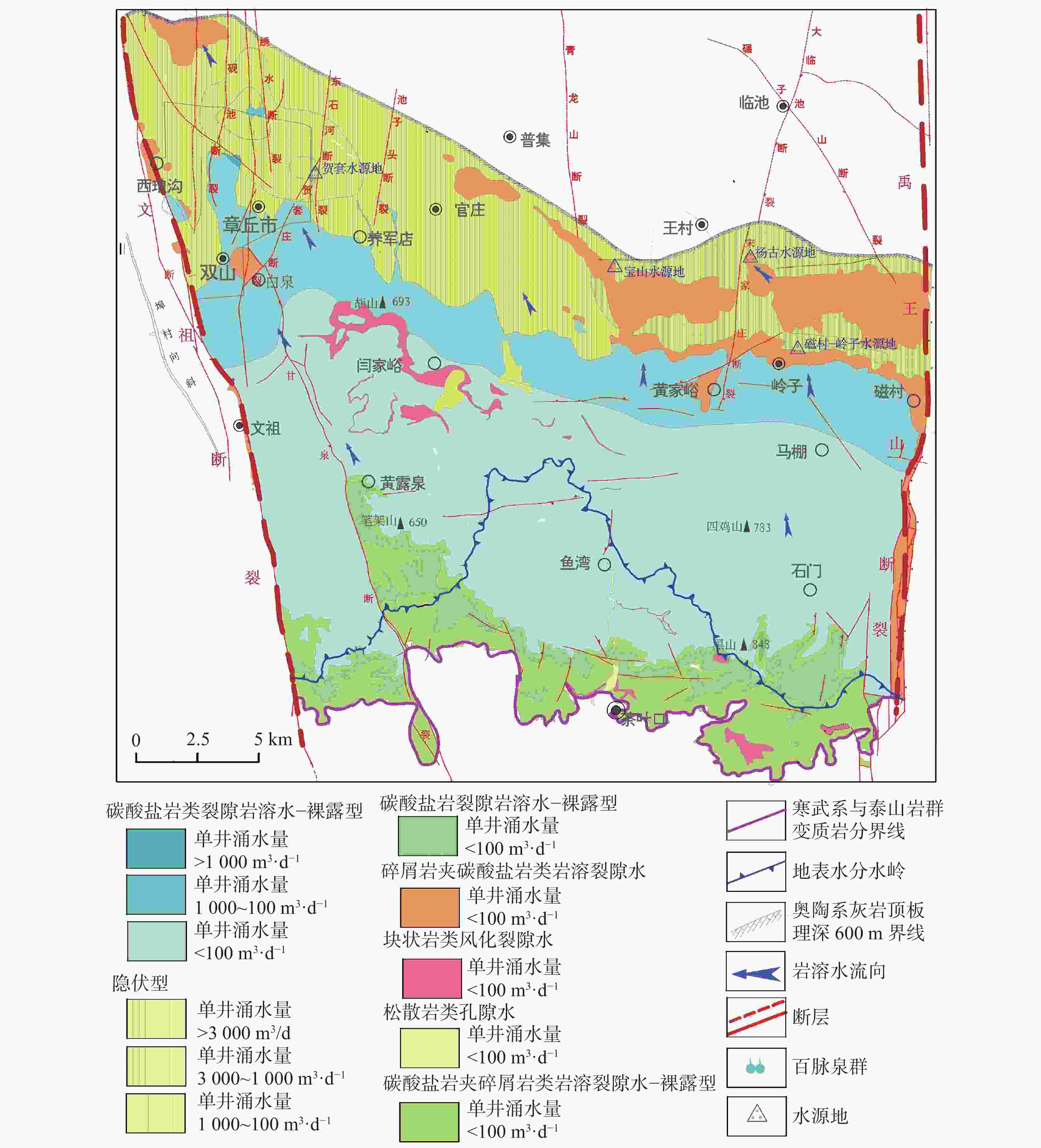
 下载:
下载:
